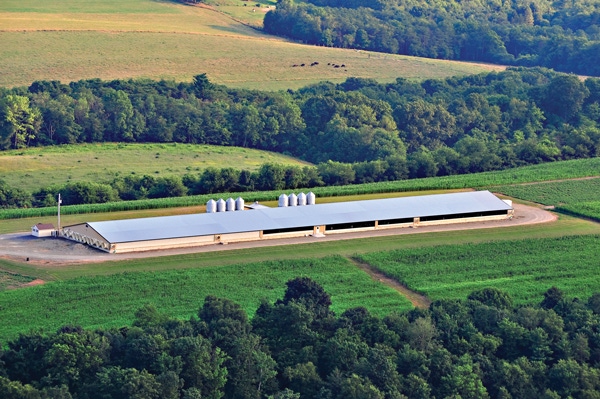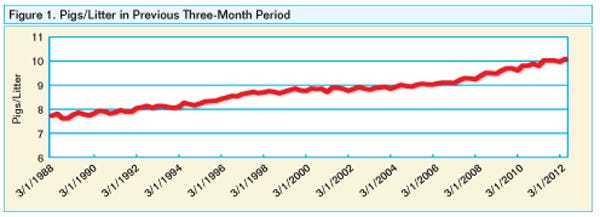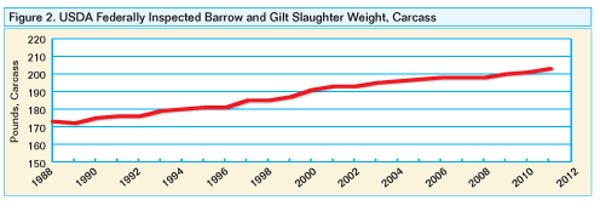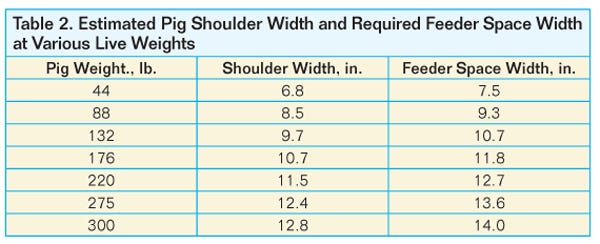Change is the one constant in the pork industry, although production facilities represent a fixed investment that is difficult to change. This conundrum sets up a conflict between the changing needs of the pigs and the facilities we have available to house them.
October 15, 2012

Change is the one constant in the pork industry, although production facilities represent a fixed investment that is difficult to change. This conundrum sets up a conflict between the changing needs of the pigs and the facilities we have available to house them.
No matter what perspective we take, pig performance has improved over the last 20 to 30 years. Figure 1 shows the pigs/litter for the previous three-month period as reported in the quarterly USDA Hogs and Pigs report since 1988. U.S. producers now average just over 10 pigs weaned/litter. This improvement in the number of pigs born alive, nursed and weaned has not been accompanied by changes in our basic farrowing facilities to accommodate larger lactating females nursing larger litters.

Almost all farrowing crates in use in the United States measure 5 ft. wide by 7 ft. long. Two feet of the 5-ft. width accommodates the lactating female, while 18-in. pig creep areas are provided on each side. This dimension worked well when the lactating female only weighed 400 lb. and nursed just 7-8 pigs. That female’s body length was short enough to be able to lie in the crate without the feeder/head gate interfering with her comfort. With only eight pigs nursing and a female that was only average for milk output, the creep area was large enough for the piglets to have a safe lying area.
Today’s lactating females must have a longer body to provide adequate teats and nursing space for their larger litters. At the same time, the design of farrowing crate head gate feeders is evolving as we improve our ability to truly ad libitum feed the lactating female.
Producers building new farrowing units are now beginning to install crates that are 5.5 ft. wide and 7.5 to 8.0 ft. long. Renovation of older farrowing facilities is often limited by concrete flooring and manure handling systems under the crates. Room partitions, too, can be a limitation if aisles must be maintained for people and pig movement.
More, Heavier Pigs
While the drought of 2012 may cause producers to reduce slaughter weights in the short term, the long-term trend is toward heavier pigs at slaughter. On average, U.S. producers have added 1.4 lb./year to barrow and gilt carcass weights from 1988 through 2011 (Figure 2). If this trend continues, by 2024 market hog carcasses could average 220 lb., which translates to 290-295 lb. on a live weight basis. Many could be marketing pigs weighing 320 lb. or more.

Likewise, as litter sizes increase, producers have improved their heat detection and mating techniques. The number of litters/female/year has increased in a similar manner, which means the size of the breeding herd in North America can be reduced while maintaining or even increasing the number of pigs produced (Figure 3).

This increase in breeding herd productivity and the corresponding increase in market weights has increased the need for wean-to-finish spaces on North American farms relative to the number of sows maintained. Based on the combined U.S. June 1, 2012 inventory and the Canadian July 1, 2012 inventory, we now have 10.1 pigs in the “kept for market” category (i.e., wean-to-finish) for every female in the breeding herd.
The annual increase in slaughter weights has challenged production facilities and equipment. The basic facility and equipment needs of importance are space (area/pig), feeders and drinkers. These represent the large initial capital investments in production facilities and are often the hardest items to change once in place.
Stocking Density
The impact of space allocation on pig performance is well understood. When pigs are forced to grow with less than adequate space per pig, daily feed intake and daily gain are reduced with minimal impact on feed conversion efficiency.
While data is limited on the space requirements of pigs grown to heavier final weights, the best estimate for maximum individual pig performance is 8.55 sq. ft./pig, if the first pig is removed from a pen when the average weight is 250 lb.
In fully slotted facilities, the best estimate is that for each 3% change in space allocation below the space defined as “adequate,” daily gain and daily feed intake are reduced by 1%.
In the United States, the average stocking density in grow-finish
facilities is estimated at about 7.2 sq. ft./pig. Using the 1% reduction in gain for each 3% reduction in space model, this stocking density is predicted to reduce gain by a little more than 5%, overall, compared to pigs grown in facilities with adequate space and the first pigs removed from the pens (topped off) when the pen average weight is 250 lb. (Table 1).

However, as we grow entire pens of pigs to heavier weights and delay the removal of the first pig(s) to slaughter, the impact worsens. For example, if the pen average weight at the time the first pig(s) is removed is 275 lb. and the stocking density is 7.2 sq. ft./pig, the overall rate of daily gain during the grow-finish period is estimated to be reduced by 7.2% due to the impact of stocking density.
This reinforces the importance of stocking density management as sale weights increase — especially if no adjustment is made in the number of pigs placed in a facility. Furthermore, if producers and growers have uneven numbers of pigs per pen, the pens with more pigs will have even slower rates of gain.
The impact of uneven stocking density at heavier sale weights can be estimated by modeling the impact in a facility with pens that measure 10 x 23.5 ft. These pens are often stocked with 32 pigs/pen (7.34 sq. ft./pig).
Assuming no death loss, if the first pigs in the pen are removed to slaughter when the average weight is 270 lb., daily gain in the pen is predicted to be reduced 6.7% due to the impact of crowding. If only 30 pigs are placed in one 10 x 23.5 ft. pen (7.8 sq. ft./pig) and 34 pigs are placed in another pen, (6.9 sq. ft./pig), daily gain will be reduced by 5% and 8.3%, respectively.
When stocking density is uneven, either the sale weights from the facility are compromised (especially on the last pigs removed from the facility or in the number of pigs that fall outside of the packer’s ideal payment grid) or the turns/year for the facility will be reduced.
The interaction of heavier weights and space allocation is also evident on pig performance after one or more pigs are removed for sale or slaughter. While published data is limited on this topic, production system experience suggests that the more crowded a pen is prior to removal of pigs, the greater the expected increase in daily gain by the remaining pigs in the pen when more space becomes available. This observation highlights the importance of removing one or more pigs from every pen at the time of first sale so that all pens of pigs have the opportunity for faster growth in response to less crowding.
Failure to sell from every pen means the pigs in the pens with no pig removal become increasingly crowded and feed intake and gain become even more depressed, adding to the variation in pig performance in the facility.
Feeder Space
Another common limitation as pig performance increases is feeder access. Producers and equipment suppliers often “size” feeders based on the number of holes or eating positions the feeder offers without regard to the “quality” of the eating space.
Researchers at the Prairie Swine Centre, using pigs weighing up to 209 lb., concluded that the best compromise for feeder depth (distance from the front lip of the feeder pan to the feed delivery point) for grow-finish pigs ranged from 8.9 to 13.3 in., or an average (ideal) of 12.6 in. This suggests that the majority of the feeders installed in production facilities today, which have feeder depths of only 8 to 10 in., are limiting pig performance as sale weights climb.
The problem with increasing feeder depth is when smaller pigs are placed, they often step into the feeder to access feed, then track it out of the feed pan. However, this has not been an issue with wean-to-finish feeders where pigs are grown from 12 lb. to slaughter weight on the same feeder.
In my experience, as sale weights increase, feeders must have at least 10 in. of depth from the front lip to the feed delivery device or agitator plate, with 11-12 in. preferred for dry feeders. If the distance is less than this, pigs end up pushing against the feeder with the crown of their forehead and/or have difficulty accessing the feed agitator plate.
The width of the feeding space is defined by the shoulder width of the pig. To allow for pig movement at the feeder, feeder spaces should be sized based on 1.1 times the shoulder width. Table 2 lists estimated shoulder widths in relation to pig weight and the estimated width of feeder spaces based on these shoulder width dimensions. This table supports the recommendation that feeders for today’s production facilities should have a minimum feeder space width of 14 in.

Table 2 also highlights a common feeder problem with swine nursery units. Many nurseries house pigs to 55 lb. or heavier. The vast majority of nursery feeders sold in the United States still have feeder holes that are 6 x 6 in. Based on shoulder dimensions, these feeders most likely limit feed intake or at least limit pig access to feed by limiting the number of usable spaces that pigs can eat from unless the spaces/holes are 8 in. wide.
Finally, genetic and nutritional improvements have increased the rates of lean deposition in pigs since the move to confinement production began in the 1970s. As a result, heat generated by the growing pig has increased. The best estimate is that metabolic heat production increases 12-15% every 10 years (Figure 4 ).

While data on heat production in growing pigs generally stops at 220 lb., there is no reason to suspect that the trend doesn’t continue with increased sale weights. This seems especially likely since the U.S. pork industry now routinely sells a portion of its barrows and gilts with 52-54% lean content at carcass weights of 220 lb or heavier. This suggests that facilities and equipment for the next generations of pigs will need to change if we expect pig performance to continue to improve.
Facility and equipment decisions need to be made with an eye to the pig flow needs in the next decade or two. Ensuring that facilities and equipment are “right sized” is a constant challenge when the right size continues to change. Even when they are right-sized, they can still be managed to give results that are “wrong sized.”
You May Also Like



